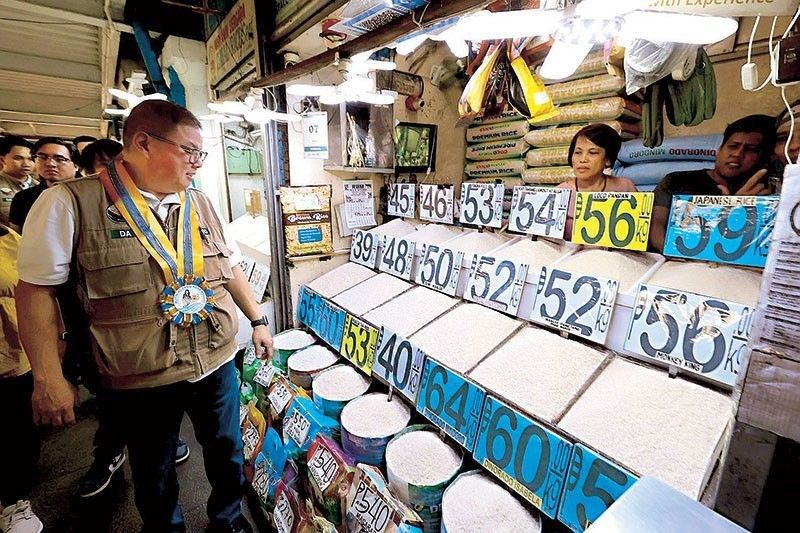DA short of target on food security

MANILA, Philippines — The Department of Agriculture (DA) has failed to meet its target on the declaration of a food security emergency as the agency still awaits the signed approved resolution by the National Price Coordinating Council (NPCC).
At a press conference yesterday, Agriculture Assistant Secretary and spokesman Arnel de Mesa assured the public that the implementation of the food security emergency would still push through despite the delay of Agriculture Secretary Francisco Tiu Laurel Jr.’s approval.
“We are still awaiting the copy of the NPCC resolution. We were advised that the resolution is being circulated to member agencies for their signatures. Although it is already approved, we still need the signed copy of the approved resolution,” De Mesa said.
He earlier said Tiu Laurel expects to sign the food security emergency by Jan. 22.
“We anticipated that we will receive the copy of the signed resolution last Monday (Jan. 20). As committed by the secretary, the DA will review as part of due diligence in two days; afterwards, the possible declaration can be made. Since the copy of the resolution is still not with us, then we cannot do anything about it,” De Mesa added.
The DA still targets to release the stocks of the National Food Authority (NFA) beginning Feb. 1 despite the delay in the declaration of the food security emergency, according to the agriculture official.
“If we can release (the food security emergency) this week, we are still within the Feb. 1 target, but definitely, there will be adjustment later on,” he said.
Under the newly enacted Republic Act 12078, or the Agricultural Tariffication Act, the DA – upon the recommendation of the NPCC – may declare a food security emergency to address supply shortages or extraordinary increases in rice prices.
A declaration of food security emergency will allow the NFA to release its rice buffer stocks to the market and replace them with locally produced palay.
Tiu Laurel has said that the unloading of 300,000 metric tons (MT) of rice from the NFA warehouse to consumers would help bring down the prices because it would augment supply.
De Mesa said the declaration of food security emergency is still necessary despite a downtrend in the retail price of rice as there are markets that still sell higher than the maximum suggested retail price (SRP) of P58 per kilo, which took effect on Jan. 20.
“(The food security emergency) is still needed as we need to release the stocks of the NFA, and although (the retail price of the staple) is already in the downward trend, based on our market visit, there are (retailers) who still sell at high prices,” he added.
The DA official cited the case of Trabajo Market in Manila, where retail prices of rice are still at P60 per kilo and higher.
He said no penalty would be imposed against violators of the maximum SRP for two weeks.
“We are still at the monitoring stage at present. We want to give ourselves at least two weeks to review this and then our coordination with the Department of Trade and Industry (DTI) will continue, as well as with local government units. After two weeks, we can have some finality with the guidelines,” he added.
Tiu Laurel issued Administrative Circular 1 on the maximum SRP, but did not include the guidelines.
“The DA has no mandate on penalties, so we cannot really impose penalties. That’s why we need to coordinate with the DTI, like its fair trade enforcement bureau and other offices, government agencies that might have a mandate in imposing sanctions (against violators of the maximum SRP),” De Mesa said.
P9 billion additional budget needed for rice buffer
The NFA needs an additional budget of P9 billion to meet the 15-day rice buffer stocking mandate under RA 12078, according to its administrator Larry Lacson.
Lacson said it would need to secure additional funding to cover the increase in the national rice buffer stock mandated under the amended Rice Tariffication Law.
Under RA 12078, the mandated rice buffer stock of the NFA has been set at 15 days of national rice consumption requirement.
Previously, the NFA’s rice buffer stock target was at nine days nationwide.
Lacson explained that the increase in rice buffer stocking mandate would mean an additional six days of reserve which is equivalent to about 300,000 MT of palay.
“We were initially allocated a budget of P9 billion for buffer stocking this year, based on the nine-day requirement. But the additional six days will necessitate an extra P9 billion for palay procurement considering that our palay price procurement per kilo increased in 2024,” Lacson said.
In a separate development, the NFA Council, the agency’s highest policymaking body, on Tuesday approved a resolution that will enable the NFA to sell rice to local government units (LGUs) for disaster preparedness.
Lacson noted that the NFA should ideally release around 25,000 MT of rice every month to LGUs without jeopardizing the buffer stock needed to respond to emergencies, calamities or a national food emergency declaration aimed at stabilizing rice supply and prices.
Earlier, Tiu Laurel, who also chairs the NFA Council, said that NFA would be selling rice to LGUs at P36 per kilo so that the latter can sell the stocks at a retail price of P38 per kilo.
“But by March, we want to sell the NFA rice stocks at P33 per kilo, so that LGUs and other participating government units can sell it to the market at P35 per kilo,” he added.
The sale of NFA’s rice stocks to LGUs and eventually to the market under a food security emergency is one of the measures also being eyed to decongest the grains agencies’ warehouses in time for the dry season harvest.
“The warehouses are full – they have almost 300,000 metric tons of rice – and harvest season is coming. If the warehouses are full, then the NFA will not be able to buy palay from local farmers at a good price,” Tiu Laurel said.
He noted that the NFA’s palay procurement should ideally account for up to 20 percent of the country’s domestic production – around four million MT – to be able to make a dent in the local rice market.
At present, the NFA only procures three percent of the local palay production.
“The NFA used to be a market maker – both a buyer and seller of rice. Now, it is restricted to buffer stocking and buying rice from local rice farmers. We aim to restore its influence on palay pricing by purchasing more local rice, helping to boost Filipino farmers profitability,” the agriculture chief said. – Jasper Emmanuel Arcalas
- Latest
- Trending





























